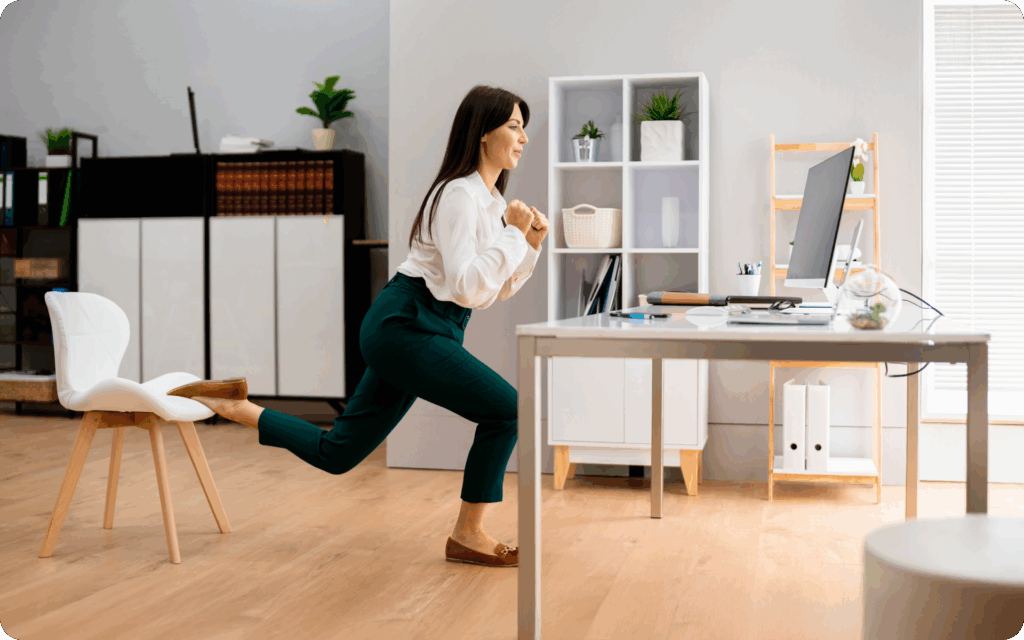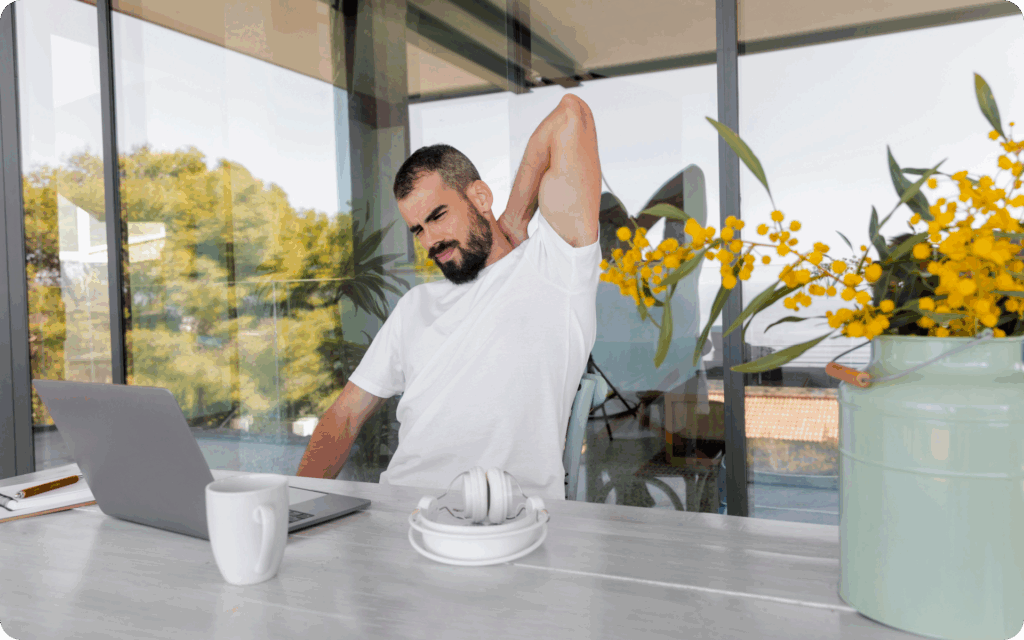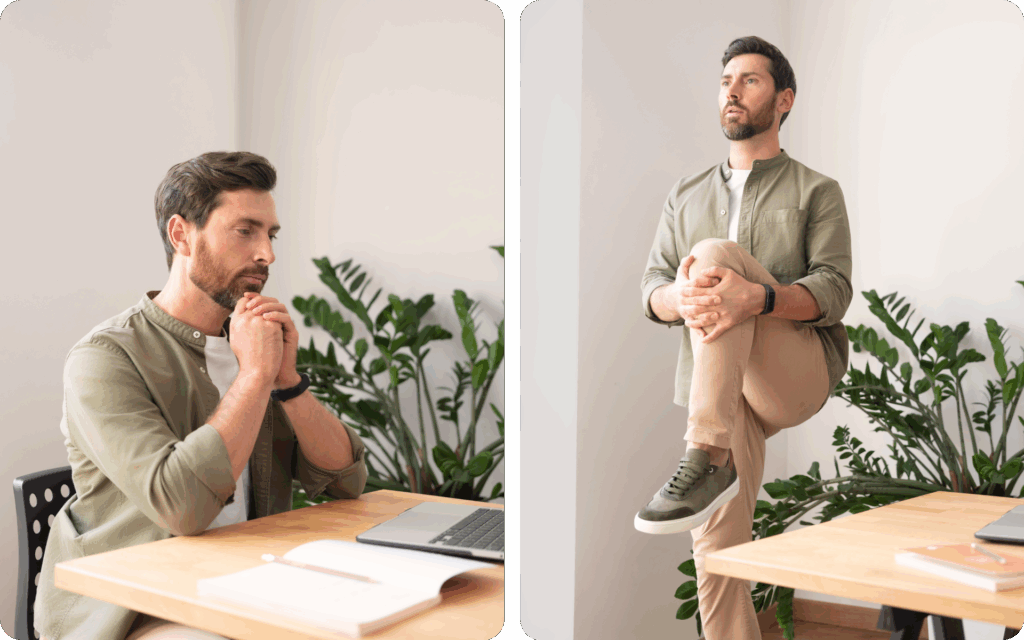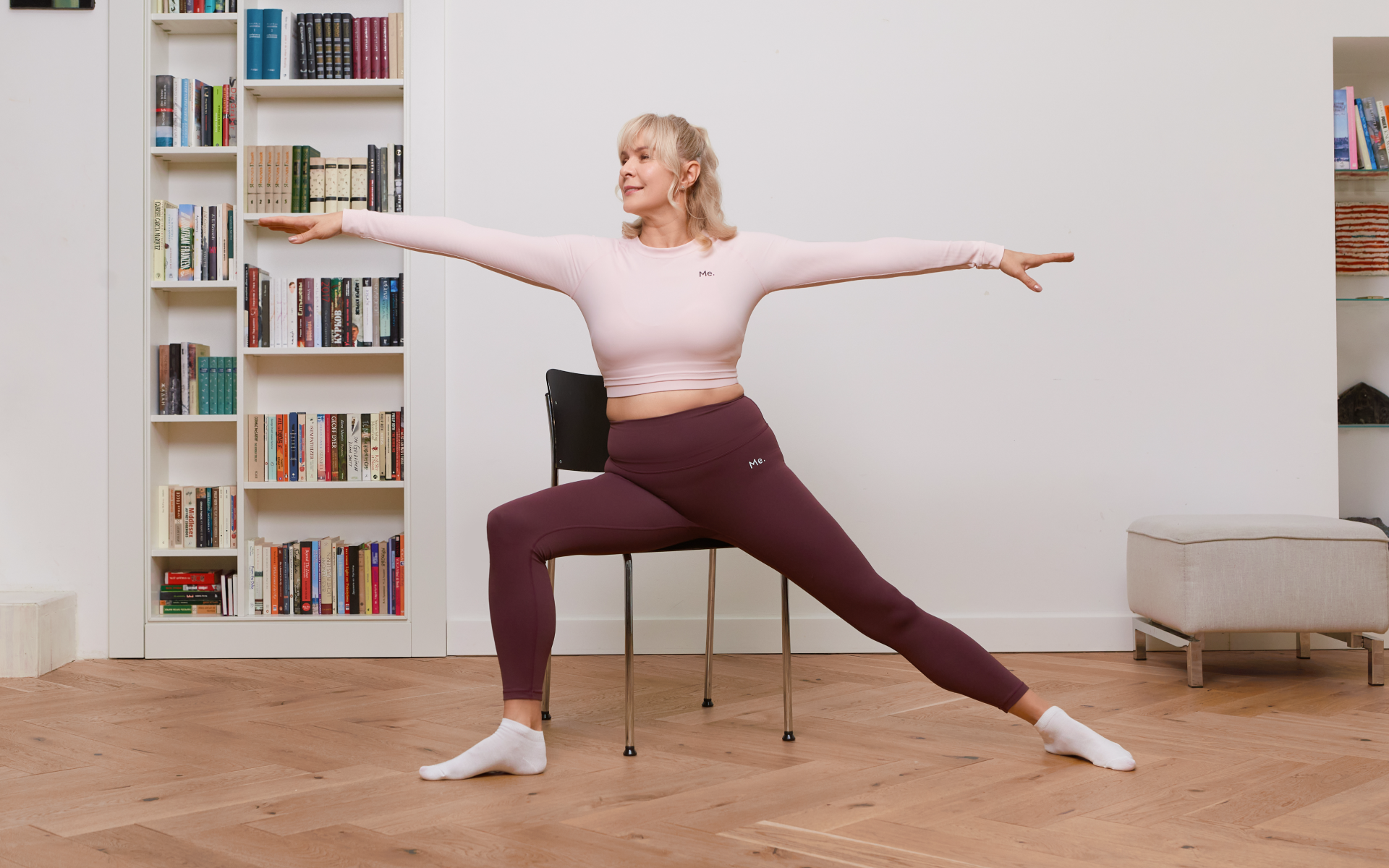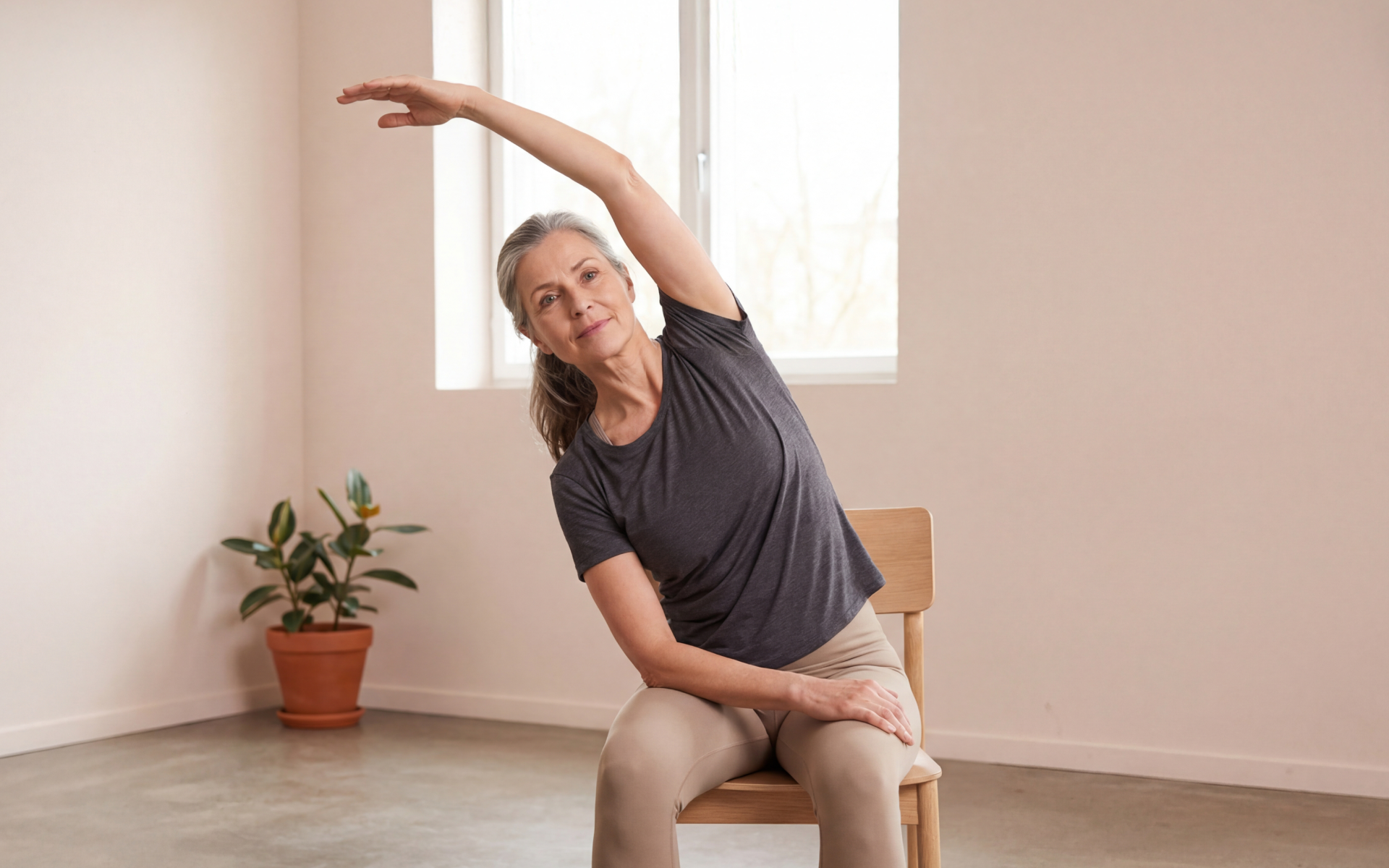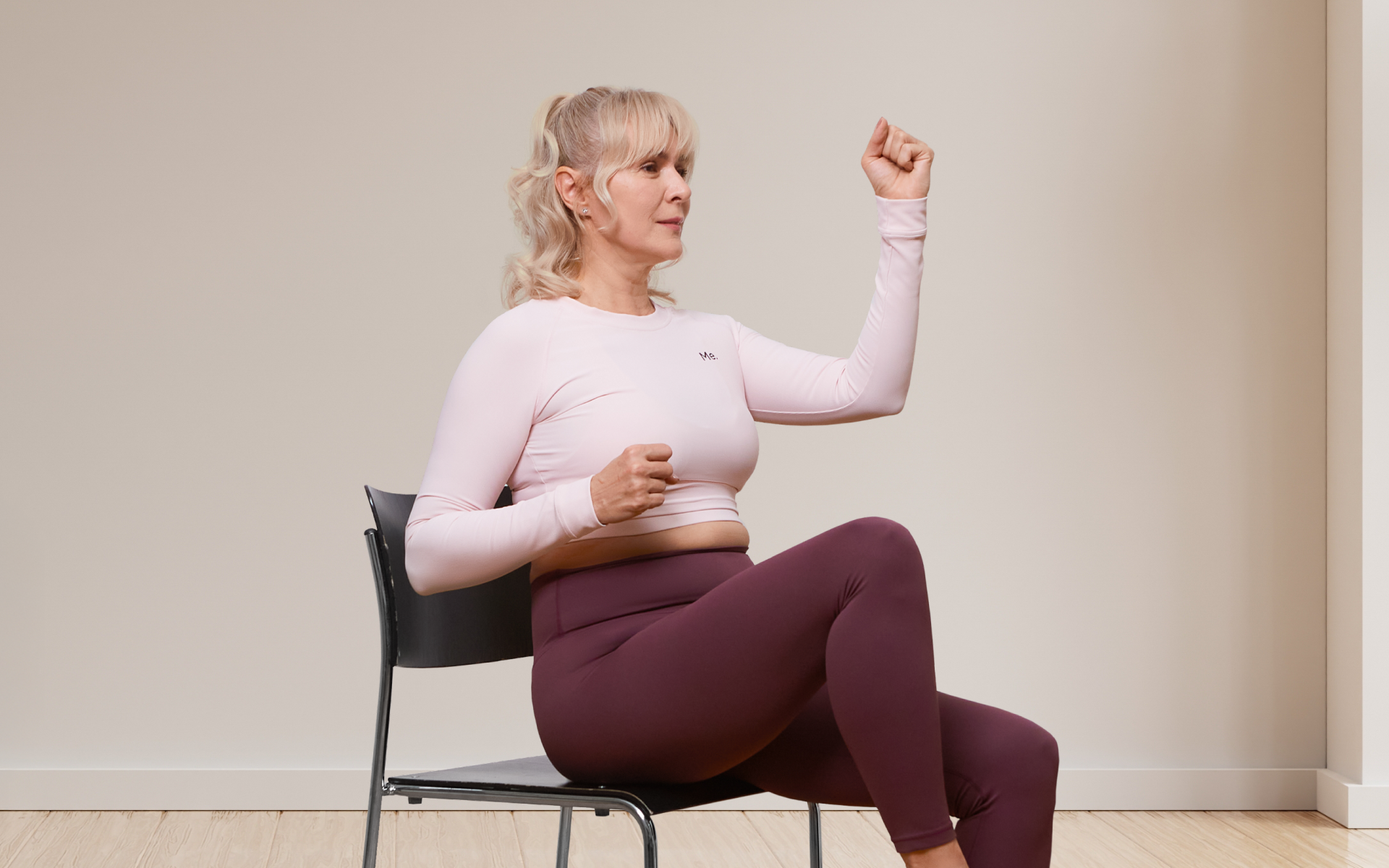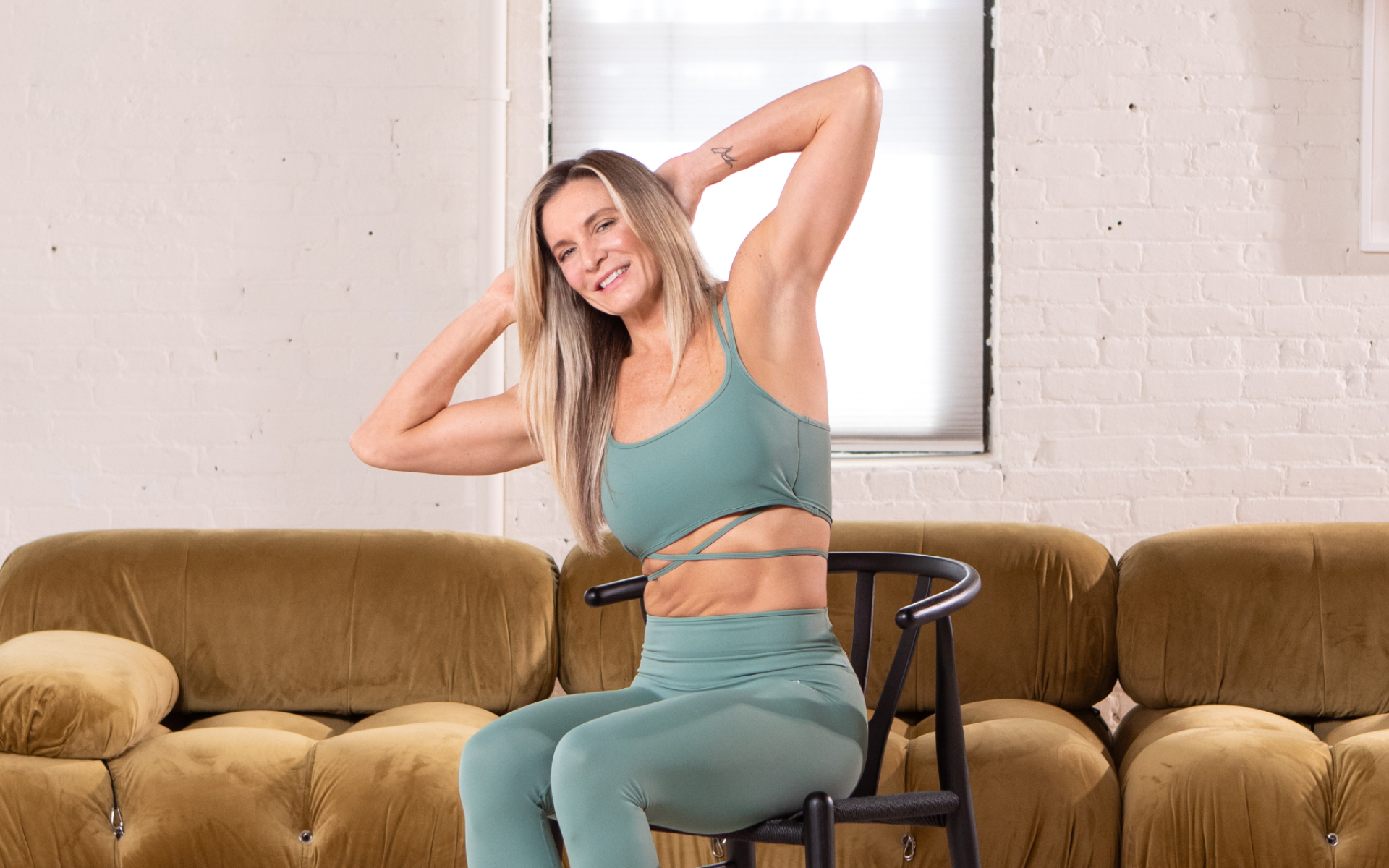Let’s face it, desk jobs don’t exactly do our bodies any favors. Hours of sitting, often without proper posture or movement, can leave you feeling stiff, tired, and downright uncomfortable. You might notice your shoulders creeping up toward your ears, your back starting to complain, or that nagging neck tension that just won’t go away.
And honestly, it’s something I’ve experienced too, and more times than I’d like to admit.
That’s precisely where desk yoga poses come in. These aren’t complicated or time-consuming routines; they’re simple, practical movements you can do right where you are, in your work clothes, without ever stepping away from your chair.
It’s about giving your body a break, even if it’s just for a few minutes.
In our article, we’ll explore how desk yoga poses can help you feel more at ease during your workday, improve your posture, and bring some much-needed relief to your body. Whether you’re new to yoga or just looking for something quick and doable between emails, our guide has got you covered.
What Are Ergonomic Desk Yoga Poses?
If you’ve ever caught yourself slouching in your chair or craning your neck toward the screen, you’re definitely not alone. That’s where ergonomic desk yoga poses come into play. These movements can fit into your workspace while helping your body move in ways that reduce discomfort and encourage better posture (1).
Contrary to traditional yoga poses that might require a mat or full-body movement, desk yoga poses adapt to the seated position. They’re gentle, easy to learn, and built with fundamental office-life limitations in mind.
Think shoulder rolls that help melt away tension, seated spinal twists to release lower back stiffness, or neck stretches that feel like a reset button after staring at a screen for too long.
The word “ergonomic” simply means designed for efficiency and comfort in a working environment. So, when we talk about ergonomic desk yoga poses, we’re talking about movements that support how your body naturally wants to sit, move, breathe, and that too, in a chair. They’re not flashy, and they don’t require flexibility. What they do offer is relief, awareness, and a better way to treat your body while you work.
Here’s what makes desk yoga poses ergonomic:
- They involve sitting poses. No need to stand, roll out a mat, or change clothes.
- They target common tension areas, such as the shoulders, neck, lower back, and hips.
- They focus on posture support, helping to align the spine and open up tight muscles (2).
- Movements are repetitive and straightforward, making them easy to remember and do regularly.
- They work with your workspace, not against it. Think chairs, desks, and screens.
The best part? You can start right now because there’s no need to wait for the next break or block out extra time.
Read more: 10-Minute Chair Yoga Flow for Beginners
How To Do Desk Yoga?
Starting desk yoga might sound a little intimidating, especially if you’re new to yoga in general or are feeling awkward about exercising at work. But the truth is, it’s surprisingly simple. You don’t need to be flexible. You don’t need to know Sanskrit names.
You don’t even need to stand up. All you really need is a chair, a few quiet minutes, and the willingness to check in with your body.
The key to making desk yoga poses work is to stay present with your movements.
The goal isn’t to stretch as far as possible or force your body into a shape; it’s to move gently, breathe deeply, and reset your posture and mindset.
BetterMe: Health Coaching app helps you achieve your body goals with ease and efficiency by helping to choose proper meal plans and effective workouts. Start using our app and you will see good results in a short time.
Here’s a step-by-step way to begin:
1. Settle Into Your Chair
- Sit up tall, with both feet flat on the floor.
- Let your hands rest on your thighs or on your desk.
- Soften your shoulders and gently lift the crown of your head.
2. Start With Your Breath
- Inhale deeply through your nose, slowly filling your lungs.
- Exhale fully through your mouth or nose.
- Try 3–5 slow breaths to begin. This slow breathing instantly calms the nervous system (3).
3. Add Gentle Movements
Start with just a few foundational desk yoga poses.
For example (4):
- Seated neck stretch: Drop your right ear toward your right shoulder and breathe. Switch sides after 3–5 breaths.
- Shoulder rolls: Roll your shoulders up, back, and down in slow circles.
- Seated cat-cow: Round your spine forward, tucking your chin, then gently arch your back while lifting your chest.
4. Work With What You Have
- Use the back of your chair to support gentle twists.
- Let your desk become a prop for light forward folds or wrist stretches.
- If your chair has wheels, lock them or sit near a wall for stability.
5. Keep It Short And Sweet
- Even just 2-5 minutes of movement can refresh your body and mind.
- If you have more time, repeat a few poses or add some breathing techniques.
Read more: 6 Beginner Chair Yoga Poses to Get You Started
How Can Desk Yoga Poses Help You Feel More Relaxed At Work?
Stress at work is almost inevitable. Whether it’s tight deadlines, back-to-back meetings, or sitting for long stretches without a break, the pressure tends to build up, not just mentally, but physically too.
You might notice it as tension in your shoulders, shallow breathing, or that constant sense of being “on edge.” These ailments are exactly where desk yoga poses help, offering a simple way to reconnect with your body and create a sense of calm, even in the middle of a hectic workday.
When you move, stretch, and breathe with intention, you’re not just helping your muscles; you’re also sending signals to your brain that it’s okay to relax. Even just a few minutes of movement can shift your nervous system from high-alert mode into a calmer, more focused state.
Here’s how desk yoga can help lower stress levels (5, 6):
- It encourages deeper breathing, which helps lower your heart rate and clear mental fog.
- It activates your parasympathetic nervous system, the part of your body responsible for rest.
- It provides a mental break, allowing you to return to tasks with more focus and clarity.
- It helps reduce built-up tension, especially in areas where stress tends to accumulate, such as your jaw, neck, shoulders, and lower back.
- It improves circulation, which can help your body feel more energized and less fatigued.
Just stepping away mentally from the constant flow of work, even for a brief moment, makes a noticeable difference. After a few stretches and mindful breaths, there’s often a sense of calm that wasn’t there before. The pressure doesn’t magically disappear, but it becomes more manageable.
And the best part? Once you make it a habit, you’ll start noticing how much more grounded and present you feel, even on your busiest days.
Do Desk Yoga Poses Help Your Posture At The Computer?
The short answer? Yes, they absolutely can.
If you’ve ever ended the day with a sore back or noticed your shoulders creeping forward while you work, chances are the long hours of sitting are affecting your posture.
The body naturally tends to fall into less-than-ideal positions when we’re focused on screens and typing nonstop. Over time, this repeated slouching can lead to stiffness, strain, and even more fatigue.
Desk yoga is a simple, realistic solution. These stretches help you feel good in the moment and train your body to return to a more natural, upright alignment.
By gently activating the muscles that support your spine, hips, shoulders, and core, these poses work to counteract the effects of poor posture without requiring a full workout (7).
Here’s how desk yoga supports better posture:
- It brings awareness to your sitting position, encouraging you to lengthen your spine rather than collapsing into your chair.
- It strengthens key stabilizing muscles, like those in your back and abdominals, which are essential for sitting upright with ease (8).
- It opens up tight areas, especially the chest and shoulders, which tend to round forward from long-term computer use (9).
- It supports your spine’s natural curves, helping you sit more comfortably and sustainably for long periods.
Over time, practicing even a few desk yoga poses each day can help your body “remember” how good proper posture feels. You might notice you’re sitting taller without thinking about it, or that it takes less effort to hold yourself up straight. It’s not about being rigid; it’s about helping your body stay balanced and supported, no matter how long your to-do list is.
What Are The Best Desk Yoga Poses For Tight Shoulders?
If there’s one area of the body that takes the biggest hit from long desk hours, it’s the shoulders. Think about it, you’re typing, scrolling, leaning toward the screen, and before you know it, your shoulders are practically glued to your ears. This tightness can make you feel heavy, tense, and less focused. Luckily, desk yoga poses offer a handful of simple, effective ways to release that built-up tension.
These movements don’t just stretch your muscles; they also encourage better circulation and open up the chest, which can ease that hunched-forward posture many of us develop at the computer.
Best Desk Yoga Poses For Shoulder Relief (10, 11, 12):
- Seated Shoulder Rolls
- Sit upright with feet grounded.
- Slowly roll your shoulders up, back, down, and forward in a circular motion.
- Do 5–10 rounds in each direction.
This classic movement helps release tension from the trapezius and upper back.
- Eagle Arms Stretch
- Extend your arms forward, then cross the right arm under the left – aligning the elbows on top of one another.
- Bend elbows, bringing palms together (or as close as they comfortably go).
- Lift elbows slightly while keeping shoulders relaxed.
This movement opens the space between the shoulder blades, a spot that often feels “stuck” after hours at the desk.
Whether you’re a workout beast or just a beginner making your first foray into the world of fitness and dieting – BetterMe has a lot to offer to both newbies and experts! Install the app and experience the versatility first-hand!
- Seated Neck and Shoulder Stretch
- Drop your right ear toward your right shoulder.
- For a deeper stretch, place your right hand gently on your head, without forcing.
- Hold for 3–5 breaths, then switch sides.
This stretch helps lengthen tight muscles along the neck and shoulder line.
- Chest Opener at Desk
- Sit tall and clasp your hands behind your chair (or simply interlace your fingers behind your back if space allows).
- Straighten arms gently, rolling shoulders back and down.
- Open the chest and breathe deeply for 3–5 breaths.
This pose counteracts the forward rounding caused by typing and screen work.
When done regularly, these desk yoga poses can help reduce stiffness, restore shoulder mobility, and even make breathing feel easier (13).
Many people notice that after just a few minutes of shoulder-focused stretches, their posture feels lighter and more open. Even a slight shift can make the workday more comfortable.
Which Simple Desk Yoga Poses Can You Do Without Standing Up?
Not every workday gives you the freedom to recline in your chair and stretch out fully.
Sometimes meetings run back-to-back, or you’re in a shared space where standing up for a significant stretch might feel out of place. The good news?
You don’t need to leave your chair to get the benefits of desk yoga poses.
There are plenty of movements you can do without standing that are subtle, effective, and surprisingly refreshing.
These chair-friendly stretches can loosen tension, improve circulation, and keep your body engaged, all while keeping you grounded in your seat. You can do them quietly between tasks, or even with your camera on in a video call, and no one will notice you’re giving your body a little reset.
Simple Desk Yoga Poses Without Standing (10, 11, 12):
Practicing chair yoga office routines helps ease stiffness, even during back-to-back meetings. Here’s a discreet 5-minute office chair yoga practice to incorporate whenever it feels best or when you need it most.
- Seated Spinal Twist
- Sit tall, with feet flat on the ground.
- Place your right hand on the back of your chair, and your left hand on your thigh.
- Inhale to lengthen your spine, exhale as you gently twist from the waist.
- Hold for 3–5 breaths, then repeat on the other side.
This pose relieves stiffness in the lower back and improves spinal mobility.
- Wrist and Finger Stretch
- Extend your right arm forward with the palm facing up.
- With your left hand, gently press the fingers back toward your body.
- Switch sides after a few breaths.
This stretch is perfect for releasing tension built up from constant typing.
- Seated Cat-Cow Flow
- Place your hands on your knees.
- On an inhale, arch your back, lift your chest, and look slightly upward (cow).
- On an exhale, round your spine, tuck your chin, and press your hands into your knees (cat).
- Repeat 5–8 times to loosen the spine and reset your posture.
- Shoulder Shrugs
- Lift both shoulders toward your ears, hold for a moment, then lower them.
- Repeat 5-10 times, moving with your breath.
- This simple movement relaxes the upper back and improves circulation in tight areas.
- Seated Forward Fold
- Sit toward the edge of your chair, with feet flat.
- Hinge forward from your hips, letting your arms hang toward the floor.
- Relax your head and neck, and take several slow breaths.
This pose stretches the back body and helps release built-up pressure from prolonged periods of sitting upright.
Even if you’re limited to just 2-3 of these poses in your chair, the desk yoga benefits add up. They’re easy to fit into a busy schedule, and they help your body feel more alive without drawing too much attention.
How Often Should You Take Desk Yoga Breaks During Work?
Most health experts recommend standing, moving, or stretching every 30-60 minutes during the working day (14). This time recommendation doesn’t mean you have to step away for long periods. Even a 5-minute chair yoga for beginners routine can reset your posture and refresh your focus. The important part is consistency through building small, regular breaks into your day rather than waiting until you feel stiff or sore.
A Practical Guide To Desk Yoga Breaks (15, 16):
- Every 30–45 minutes: Do 1–2 quick stretches (shoulder rolls, neck stretches, or wrist movements).
- Every 1–2 hours: Try a short sequence of desk yoga poses, like seated cat-cow, a spinal twist, or a chest opener.
- Midday Reset: Take 5–10 minutes for a mini yoga break to re-energize your body before diving into the second half of your day.
- End of the day: Use a more extended session (10 minutes or more) to release all the tension before leaving work, so you don’t carry it home with you or practice once you get home.
How To Turn This Into A Day-To-Day Habit
- Set gentle yet regular reminders (e.g., every 30–45 minutes) on your phone, computer, or calendar to make sure you are stretching or changing your posture.
- Switch postures throughout the day, even briefly, like move your head side-to-side, roll your shoulders, stretch your wrists, or twist your torso.
How To Make Desk Yoga A Daily Work Habit?
Knowing that desk yoga poses are good for you is one thing, but incorporating them into your daily routine is a whole other challenge. Between meetings, deadlines, and constant notifications, it’s easy to push doing exercises aside.
The key is to make desk yoga feel like a natural part of your workday, rather than “one more thing to do.”
Practical Ways To Build The Habit:
Start Small and Simple
- Begin with 1-2 poses, like shoulder rolls or a seated spinal twist.
- Doing a couple of minutes consistently is far more effective than aiming for 15 minutes and skipping it altogether.
- If you have limited space, using a yoga chair for desk stretches can be surprisingly effective.
Link It to Something You Already Do
- Pair your stretches with daily habits, like checking emails, finishing a call, or grabbing a glass of water.
- When you anchor new actions to existing routines, they’re more likely to stick.
Use Reminders and Alarms
- Set a timer, calendar alert, or even a sticky note on your monitor with a phrase like “Sit tall” or “Breathe.”
- These cues serve as nudges to pause and move.
Keep It Comfortable and Discreet
- You don’t need to make significant, dramatic movements.
- Subtle stretches that fit naturally into your chair are enough, and they make it easier to practice even in shared workspaces.
Track Your Progress
- Jot down in a notebook or use a digital tracker like BetterMe to mark when you complete a session.
- Seeing your consistency build over time can be motivating.
Focus on How It Feels, Not How It Looks
- The more you notice the release of tension, improved focus, or extra energy after a few poses, the more likely you’ll look forward to doing them again.
- By making desk yoga a habit rather than an afterthought, you’ll start to notice it becomes almost automatic, just like sipping water or checking your calendar.
Where Can Beginners Learn Desk Yoga Poses Easily?
If you’ve never tried yoga before, the thought of doing it at your desk might sound a bit odd. But honestly, desk yoga poses for beginners are some of the easiest ways to start.
They’re short, they don’t require fancy gear, and no one’s grading you on how perfect your stretch looks. The trick is just starting, so it doesn’t feel intimidating anymore.
- Written guides are helpful, especially ones with pictures. Sometimes, though, the text can feel a bit stiff, so don’t be afraid to experiment and move in a way that feels natural.
- Short videos are even better for many people. A 2-minute clip can show you everything you need without overcomplicating it.
- Workplace wellness programs, if your company offers them, are worth exploring. They often sneak yoga in as “movement breaks,” and it’s a nice way to learn without pressure.
- And yes, apps or online platforms can be helpful too, though sometimes they give you way more than you need when you’re just looking for a quick shoulder roll.
At the end of the day, learning desk yoga doesn’t have to be a big project. Pick one pose, try it, see how it feels. That’s the first step.
You can stay active at your desk by doing stretches, seated twists, and desk yoga poses that move your spine, shoulders, and wrists without leaving your chair. Chair yoga supports gentle movement and mindfulness, which can aid in overall fitness, but losing belly fat also depends on balanced nutrition and regular physical activity. Yes, chair yoga is especially beginner-friendly since it uses simple movements and offers support through the chair, making it easy to start. Absolutely! Just 10 minutes of yoga a day can improve flexibility, posture, and stress levels, especially if practiced consistently.Frequently Asked Questions
How to get exercise while sitting at a desk?
Can you lose belly fat with chair yoga?
Does chair yoga really work for beginners?
Is 10 minutes of yoga a day enough?
The Bottom Line
Long hours at a desk don’t have to leave your body stiff and your energy drained.
By adding a few desk yoga poses into your daily routine, you can loosen tight muscles, refresh your mind, and sit with better posture, all without leaving your chair.
The key is to keep it consistent and straightforward, not complicated or time-consuming.
Whether it’s a couple of stretches every hour or a short midday routine, the benefits build over time. Small, mindful breaks aren’t just good for your body; they can make your entire workday feel a little lighter and more balanced.
DISCLAIMER:
This article is intended for general informational purposes only and does not serve to address individual circumstances. It is not a substitute for professional advice or help and should not be relied on for making any kind of decision-making. Any action taken as a direct or indirect result of the information in this article is entirely at your own risk and is your sole responsibility.
BetterMe, its content staff, and its medical advisors accept no responsibility for inaccuracies, errors, misstatements, inconsistencies, or omissions and specifically disclaim any liability, loss or risk, personal, professional or otherwise, which may be incurred as a consequence, directly or indirectly, of the use and/or application of any content.
You should always seek the advice of your physician or other qualified health provider with any questions you may have regarding a medical condition or your specific situation. Never disregard professional medical advice or delay seeking it because of BetterMe content. If you suspect or think you may have a medical emergency, call your doctor.
SOURCES:
- The Benefits of Physical Activity for Health and Well-Being (2012, International Journal of Environmental Research and Public Health)
- The Effect of Chair-Based Exercises on Health Outcomes in Older Adults: A Systematic Review (2025, Journal of Bodywork and Movement Therapies)
- The Effect of Sedentary Behavior Interventions in Workplace Settings: A Systematic Review (2023, Health Policy)
- Ergonomic Exercises for Office Workers (n.d., National Institutes of Health – Office of Research Services)
- Sedentary Behavior and Health: Update from the 2018 Physical Activity Guidelines Advisory Committee (2020, Medicine & Science in Sports & Exercise)
- The Effect of Workplace Physical Activity Interventions on Musculoskeletal and Cardiovascular Health (2011, BMC Public Health)
- The Impact of Workplace Sedentary Behavior on Health Outcomes (2015, Occupational Medicine)
- Chair Yoga and Why Seated Yoga Poses Are Good for You (2024, Brown University Health)
- Effects of a Brief Workplace-Based Seated Yoga Intervention (2021, Global Advances in Health and Medicine)
- Energizing Chair Yoga (2024, BetterMe)
- Energize Your Workday with Upper Body Chair Yoga (n.d., Allina Health)
- Chair Yoga: Benefits of a Mind-Body Practice Without the Risk of Falling (2025, Harvard Health Publishing)
- Effects of Chair-Based Yoga on Physical Function in Older Adults (2023, Healthcare (Basel))
- Microbreaks: Small Breaks to Improve Health and Productivity (n.d., Stanford Environmental Health & Safety)
- Rest Breaks and Office Ergonomics (n.d., UCLA Health)
- Work Routine and Taking Breaks When Using Display Screen Equipment (n.d., Health and Safety Executive – UK)
